1500+ ★★★★★ REVIEWS
Understanding Androgenetic Alopecia: Causes, Treatments, and Solutions

Androgenetic alopecia (AGA), commonly known as male or female pattern baldness, is the most prevalent form of hair loss worldwide, affecting millions of individuals. Characterized by a receding hairline or thinning hair, AGA can significantly impact self-esteem and quality of life. This article delves into the causes, medical treatments, and non-medical solutions for androgenetic alopecia, offering a comprehensive guide for those seeking to address this condition.
What is Androgenetic Alopecia?
Androgenetic alopecia is a genetically determined, progressive form of hair loss mediated by androgens, particularly dihydrotestosterone (DHT). In men, it typically presents as a receding frontal hairline and thinning at the crown, while in women, it often manifests as diffuse thinning over the top of the scalp with preservation of the frontal hairline. According to MedlinePlus Genetics, AGA affects approximately 50 million men and 30 million women in the United States alone, with prevalence increasing with age.

The condition arises from the miniaturization of hair follicles, a process where terminal hairs (thick, pigmented hairs) transform into vellus hairs (short, fine, unpigmented hairs) due to the effects of DHT. This hormone, derived from testosterone via the enzyme 5-alpha-reductase, shortens the anagen (growth) phase of the hair cycle, leading to progressively thinner and shorter hair until follicles cease producing hair altogether.
Causes and Risk Factors
AGA is primarily driven by genetic predisposition and hormonal influences. Research published in the Journal of Cosmetic Dermatology highlights that AGA is an autosomal dominant condition, meaning it can be inherited from either parent. Variants in the androgen receptor gene increase sensitivity to DHT, exacerbating hair loss in susceptible individuals.
Environmental and lifestyle factors also play a role. Stress, poor nutrition, and smoking may aggravate AGA, though their exact contributions remain under investigation. Conditions like polycystic ovary syndrome (PCOS) in women, which elevates androgen levels, are also linked to increased risk, as noted by MedlinePlus Genetics.
Medical Treatments for Androgenetic Alopecia

Several evidence-based medical treatments can slow or reverse AGA progression. These options target the underlying hormonal and follicular mechanisms:
- Topical Minoxidil: Approved by the FDA, minoxidil is a vasodilator applied to the scalp to prolong the anagen phase and increase blood flow to hair follicles. Studies in the American Journal of Clinical Dermatology demonstrate its efficacy in both men and women, with 2% and 5% formulations available. Side effects are minimal, including scalp irritation in some cases.
- Oral Finasteride: This 5-alpha-reductase inhibitor, FDA-approved for men, reduces DHT levels, halting hair loss in many patients. A review in Expert Opinion on Pharmacotherapy confirms its effectiveness, though it may cause sexual side effects in a small percentage of users. It is not approved for women due to potential risks, particularly during pregnancy.
- Low-Level Light Therapy (LLLT): Another FDA-approved option, LLLT uses red light to stimulate hair follicles. Research from ScienceDirect indicates modest regrowth benefits, making it a non-invasive adjunctive therapy.
- Emerging Treatments: Platelet-rich plasma (PRP) injections and nutraceuticals like biotin or saw palmetto are gaining attention. A PMC study suggests PRP may enhance hair density, though more robust trials are needed.
Non-Medical Solutions for Androgenetic Alopecia

For those seeking alternatives to medical interventions, non-medical solutions provide cosmetic coverage and confidence restoration. These options are particularly valuable for individuals with advanced hair loss or those who prefer non-pharmacological approaches:
- Wigs: Modern wigs offer natural-looking coverage for extensive hair loss. Available in synthetic or human hair, they can be styled and customized. For high-quality options, visit Hottie Hair Salon & Extensions Store, renowned for its premium wigs tailored to individual needs.
- Hair Toppers: Ideal for partial hair loss, toppers add volume and coverage to thinning areas while blending seamlessly with natural hair. Hottie Hair’s Hair Topper Extensions provide a lightweight, versatile solution, perfect for enhancing density without full scalp coverage.
- Mesh Integration: This innovative technique integrates real hair into a breathable mesh base, offering a semi-permanent solution for thinning or bald spots. Hottie Hair’s Mesh Integration is customizable and durable, lasting up to two years with proper care, making it a standout choice for long-term wear.
- Camouflage Techniques: Styling tricks, such as strategic haircuts or scalp micropigmentation, can minimize the appearance of thinning. These methods are affordable and non-invasive, as noted in PMC research.
For expert application and personalized consultations, Hottie Hair Salon & Extensions Store in Las Vegas excels in delivering non-medical solutions that prioritize comfort and aesthetics.
Psychological Impact and Lifestyle Considerations

Beyond physical changes, AGA can affect mental health, leading to anxiety or reduced self-confidence. A study in Dermatology Research and Practice underscores the psychosocial burden, emphasizing the importance of addressing both the condition and its emotional toll. Adopting a balanced diet rich in vitamins (e.g., biotin, vitamin D) and managing stress through mindfulness may support overall hair health, though they won’t reverse AGA alone.
Conclusion

Androgenetic alopecia is a multifaceted condition with genetic, hormonal, and environmental roots. While medical treatments like minoxidil and finasteride offer proven results, non-medical solutions such as wigs, toppers, and mesh integration provide immediate cosmetic benefits. For those exploring non-medical options, Hottie Hair Salon & Extensions Store stands out as a trusted provider, offering tailored, high-quality solutions to restore confidence. Whether opting for medical or cosmetic approaches, individuals can find effective ways to manage AGA and reclaim their sense of self.
FAQ: Androgenetic Alopecia
- What causes androgenetic alopecia?
AGA is caused by a genetic predisposition to DHT sensitivity, leading to hair follicle miniaturization. Learn more at MedlinePlus Genetics. - Can women experience androgenetic alopecia?
Yes, women can develop AGA, typically as diffuse thinning rather than total baldness, often linked to hormonal changes like menopause or PCOS. - Is androgenetic alopecia reversible?
While not fully reversible, treatments like minoxidil and finasteride can slow progression and promote regrowth, per PMC studies. - What is the best medical treatment for AGA?
Topical minoxidil and oral finasteride are the most effective FDA-approved options, backed by American Journal of Clinical Dermatology. - Are there side effects to AGA medications?
Minoxidil may cause scalp irritation, while finasteride can lead to sexual side effects in men, though rare, according to Expert Opinion on Pharmacotherapy. - How does mesh integration work?
Mesh integration blends real hair into a breathable mesh base, covering thinning areas. Explore this at Hottie Hair’s Mesh Integration page. - What are hair toppers, and who should use them?
Hair toppers add volume to thinning areas and are ideal for partial hair loss. Check out Hottie Hair’s Topper Extensions. - How long do wigs last?
High-quality wigs from providers like Hottie Hair Salon & Extensions Store can last years with proper care, depending on material and usage. - Can lifestyle changes prevent AGA?
While lifestyle factors like diet and stress management support hair health, they cannot prevent AGA, which is primarily genetic, per Journal of Cosmetic Dermatology. - Where can I find non-medical solutions for AGA?
Hottie Hair Salon & Extensions Store offers expert wigs, toppers, and mesh integration, with personalized consultations to meet your needs.
You must be logged in to post a comment.